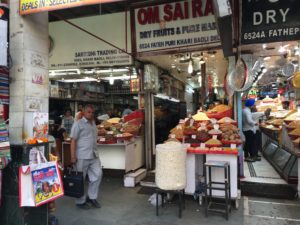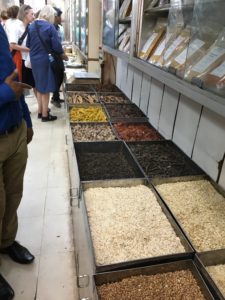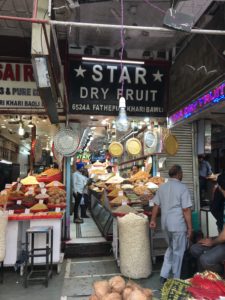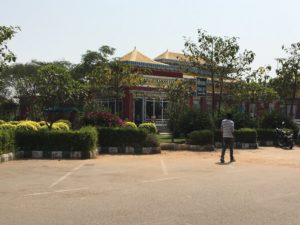
My family and I recently returned from a trip of a lifetime, spending two weeks traveling to five cities in India. The first stop was in Delhi, the capital city and home to significant history. Delhi is also home to 21 million people. To understand the scale, New York City has a population of less than 9 million people. So, Delhi is crowded. Incomparably crowded to any city in the United States, which may be the reason why retail in India, and Delhi in particular, is so different from what we experience in the US.
Part of our city tour in Delhi was visiting the famous markets of Chandni Chowk. Though we had a small private car, our guide had us pile into an auto rickshaw in order to more easily navigate the crowded market streets. Though it wasn’t easy. Mid-day on a Monday, the streets are teeming with a mix of modern delivery trucks, a mass of auto rickshaws, bicyclists, pedestrians, and hand-pulled carts with goods. There are smaller lanes which are only passable by foot, bicycle and motorbike. Motorbikes weave dangerously through the lane, and pedestrians are expected to make way.

Every street is a hub for a particular retail good. One long block is home to dozens of spice stores. Another features wedding saris. Another bicycles (yes, and entire block that just sells bicycles.) We explored a block filled with spice shops; they were small stores, maybe 10 feet across and stretching back at least 30 feet. Sharing the narrow sidewalk in front of the stores are flower vendors who weave fresh strands together into an India type of lei and paan vendors – a type of street snack food.
“How on Earth do these stores differentiate? Why would I buy spices from one and not the other?” These questions nagged me throughout our visit. We saw this type of specialization in other cities, too.
It occurred to me that the answer to my questions might be simply that the population is so large, the demand so great, that the market requires so many vendors. But that doesn’t explain the lack of any type of specialization. The spice stores literally all sold identical goods. Bulk spices. Packaged spices. Not different spices though.
There are great travel blogs that compare all the various shopping markets in India, including this recent post on markets in Delhi. But nothing I’ve read talks about how the businesses can compete or if they are differentiating at all. The set up reminds me of wholesale flower markets you might find in the US, where most of the commerce is in bulk but they do sell direct to consumer. But the difference is that these are retail shops.

In Mumbai, I had the necessary opportunity to visit a number of chemist (pharmacy) shops (I developed a terrible cough which was exacerbated by pollution, no doubt.) Again, I was amused to find rows of similar stores, even in the very high-end neighborhoods of South Mumbai where we were staying. Shop after shop, all offering a high level of personalized service with the goods behind the counter and the pharmacist/shopkeeper hand picks everything from shampoo to aloe gel to cough drops (at a cost of 1 rupee per drop) to cold and cough medications.
This set-up might be because labor, especially compared to the United States, is inexpensive in India, allowing businesses to employ many more people without impacting the price of goods. At the same time, property values are extremely high, particularly in Mumbai. This recent Forbes article includes Mumbai on a list of the 5 most expensive cities around the world. So it makes sense that shops are small.
However, I remain curious how they all sustain their business, and what, if anything, differentiates one shop from another. It was nothing obvious and I was looking for points of differentiation. Despite my marketing and business lens tuned in to experience the cultural differences, I could not figure out why this seeming redundancy of supply works in India.

In contrast to the market shopping experience in Delhi and the small shops in Mubai, we also visited modern shopping mall in Dehi (on account of my 13 year old not having packed any shorts.) It is far outside the urban center, and offered a wildly different retail experience. When we’d last visited India in 2002, there were no modern shopping malls. The rise of the middle class population in India is creating demand for consumer goods and global brands, which is fueling the retail economy in the country. The modern mall we experienced in Delhi (and then again similarly in Mumbai) reminded us of the upscale mall near us at home – the one with high end brands like Michael Kors, Burberry and Armani. Here, the retail experience was the same as at home – except I was surprised to find that there were no deals to be had while shopping these brands in India. We paid top US dollar for a pair of Nike shorts, for example. Ironic considering India is a major player in garment production worldwide; but also explainable by the price of real estate and its impact on the price of goods in these malls.
We also visited a number of tourist stores in Mumbai, meaning higher end shops complete with security to enter and prices that had us figuring we’d “just visit Pier 1 or World Market” when we returned home. The consumer in these stores appeared to be entirely foreign, and the exchange rates being offered prominently made it all the clearer that these retail establishments were not serving a domestic market. The stores also mimicked a more western retail experience, with sophisticated displays, ample aisles and kind customer service staff offering to help you find anything you are looking for. This tourist shopping experience is a contrast to what we experienced in Delhi, where despite being inside the “shopping collective” we were being pressured to see each department’s goods, at high prices, and there were dozens of idle employees manning the counters with nary a customer in sight.
A country of a billion plus residents with a rising middle class obviously demands a robust retail economy. What is interesting is how varied the retail experiences are within the country. In the United States you can certainly find a bustling farmers market or flea market, but it is not yet in the mainstream nor providing critical mass supply to the population. And we can find strip malls or street-side retail in most cities, but the best parallel to the redundancies that are observed in India are the number of Starbucks or 7-11 Stores that you might find within a small radius, or a mass of gas stations all along the same street.

And speaking of Starbucks, they are all over India, even surprisingly at a rural rest stop along the modern toll road that runs between Delhi and Agra.
https://sunrisedigital23.wordpress.com/
“contact us For Social Media and Digital Marketing”